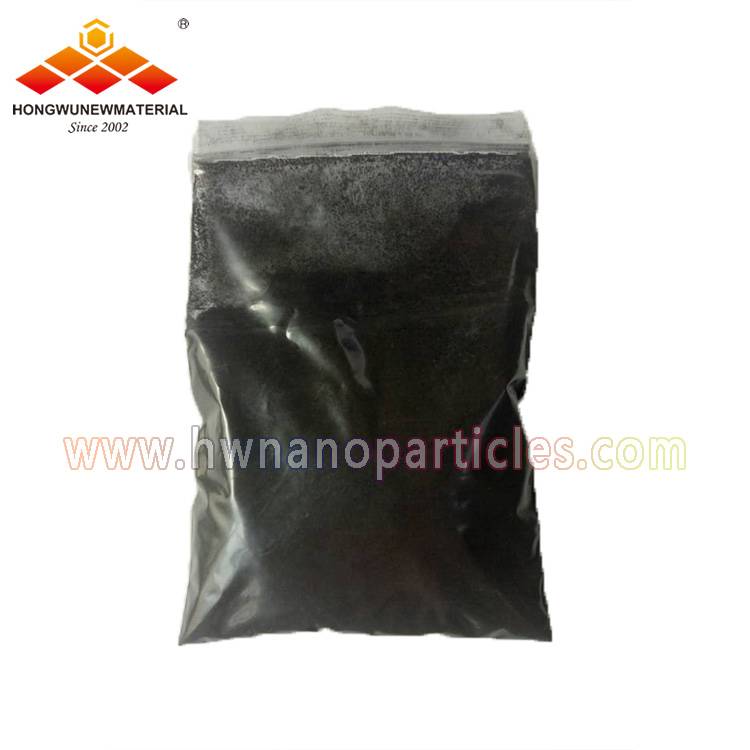
30-50nm Fe3O4 nanoparticles Iron Oxide Black
30-50nm Fe3O4 Nanoparticles Iron Oxide Black
Specification:
| Code | P632-1 |
| Name | Iron oxide black |
| Formula | Fe3O4 |
| CAS No. | 1317-61-9 |
| Particle Size | 30-50nm |
| Purity | 99% |
| Crystal Type | Amorphous |
| Appearance | Black powder |
| Package | 1kg/bag in double anti-static bags or as required |
| Potential applications | It has broad application prospects in the fields of magnetic fluid, magnetic recording, magnetic refrigeration, catalysts, medicine, and pigments, etc. |
Description:
Application of Fe3O4 nanoparticles:
catalyst:
Fe3O4 particles are used as catalysts in many industrial reactions, such as the production of NH3 (Haber ammonia production method), high-temperature water-gas transfer reaction and natural gas desulfurization reaction. Due to the small size of Fe3O4 nanoparticles, the large specific surface area, and the poor surface smoothness of the nanoparticles, uneven atomic steps are formed, which increases the contact surface for chemical reactions. At the same time, Fe3O4 particles are used as the carrier and the catalyst components are coated on the surface of the particles to prepare ultra-fine catalyst particles with a core-shell structure, which not only maintains the high catalytic performance of the catalyst, but also makes the catalyst easy to recycle. Therefore, Fe3O4 particles have been widely used in the research of catalyst supports.
Magnetic recording:
Another important use of nano-Fe3O4 magnetic particles is to make magnetic recording materials. Nano Fe3O4 due to its small size, its magnetic structure changes from multi-domain to single-domain, with very high coercivity, used as a magnetic recording material can greatly improve the signal-to-noise ratio, improve image quality, and can achieve high information recording density. In order to achieve the best recording effect, nano-Fe3O4 particles must have high coercivity and residual magnetization, small size, corrosion resistance, friction resistance and adapt to temperature changes.
Microwave absorption:
Nanoparticles have optical properties that are not available in conventional bulk materials due to the small size effect, such as optical nonlinearity, and energy loss during light absorption and light reflection, which are greatly dependent on the size of the nanoparticles. Studies have shown that using the special optical properties of nanoparticles to prepare various optical materials will be widely used in daily life and high-tech fields. The current research on this aspect is still in the laboratory stage. The quantum size effect of the nano-particles makes it a blue shift phenomenon for light absorption of a certain wavelength. The absorption of light of various wavelengths by nano-particle powder has a broadening phenomenon. Due to its high magnetic permeability, Fe3O4 magnetic nanopowders can be used as a kind of ferrite absorbing material, which is used in microwave absorption.
Adsorption removal of water pollutants and precious metal recovery:
With the rapid development of industrialization, the accompanying water pollution has become more and more serious, especially the metal ions in the water body, difficult-to-degrade organic pollutants, etc., which are not easy to separate after treatment. If a magnetic adsorption material is used, it can be easier Separation. Studies have found that when Fe3O4 nanocrystals are used to adsorb noble metal ions such as Pd2+, Rh3+, Pt4+ in the hydrochloric acid distillate, the maximum adsorption capacity for Pd 2+ is 0.103mmol·g -1 and the maximum adsorption capacity for Rh3+ is 0.149mmol·g -1, the maximum adsorption capacity for Pt4+ is 0.068mmol·g-1. Therefore, magnetic Fe3O4 nanocrystals are also a good solution precious metal adsorbent, which is of great significance to the recycling of precious metals.
Storage Condition:
Fe3O4 nanoparticles should be stored in sealed, avoid light, dry place. Room temperature storage is OK.










